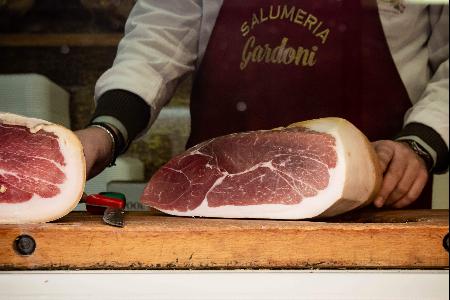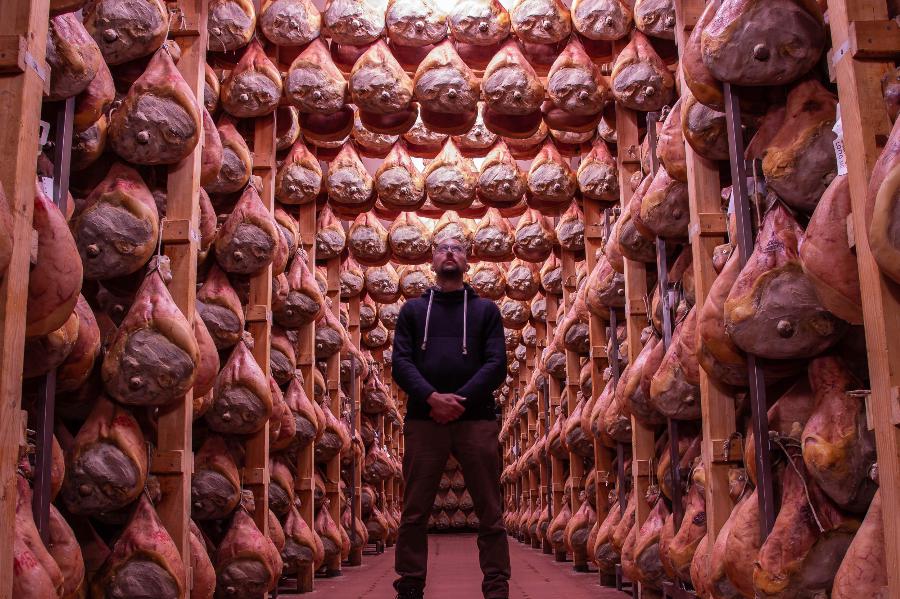Charcuterie meats are delicious but do not contain nitrates—I personally use nitrates when making some aspects of charcuterie.
In detail, I’ve studied, bought, and investigated many non-nitrite/nitrate options worldwide.
Key Points:
- Some charcuterie meats like Parma Ham, Finocchiona, and Capocollo can be enjoyed without nitrates/nitrites.
- “Nitrate-free” labels may still contain vegetable-based nitrates from sources like celery or beetroot powder.
- Traditional charcuterie production often avoids additives like nitrates, focusing on natural ingredients and craftsmanship.
- Saltpetre and modern sodium nitrates have been used for centuries to preserve meats, with sodium nitrates playing a role in commercial preservation.
If you are looking to prepare a delicious charcuterie board (to help, I have a calculator for how much meat etc. per person I created), your taste buds are probably already dancing and rejoicing. Though charcuterie meats are all the rave these days, some people are concerned about nitrates/nitrites and how they are prepared- with or without them.
Italian Cured Meats Parma Ham, Finocchiona, and Capocollo (among other uncured meats) can be found without nitrates. While some meats are marketed as “nitrate-free,” this means that no commercially produced nitrates were added; they often still contain vegetable-based nitrates such as celery or beetroot powder.
How charcuterie meats are produced is a mystery to some. Still, for those who have been preparing these types of meat for centuries, you can rest assured that there are natural and organic processes in preparing many charcuterie types of meat.
But if you are concerned about nitrate consumption, check out these charcuterie meat options.
Types of Charcuterie Meats Without Nitrates/Nitrites
- Parma Ham (Prosciutto di Parma DOP)
- Finocchiona
- Capocollo (Coppa)
Recently, countries like England and other Western countries have had a push toward no nitrate/nitrite additions. More vendors/suppliers are now selling commercially without these additions.
Parma Ham (Prosciutto di Parma DOP)

Prosciutto di Parma DOP, or Parma Ham, is one of the most delicious and delicate meat options on the market.
It is beautifully prepared, adds an incredible flavor to your charcuterie board (or many other offerings), and is one of the most finely prepared charcuterie (cured) meats.
It’s an art and craft to produce these; since the Roman Empire, these have been a delicacy.
Pork, Salt, Craft, Skill, Environmental Conditions – and at least 12 months to first cure, then dry the leg of pork.
So, you will be happy to know that Parma Ham does not have nitrates.
Of course, if you are concerned about if food has nitrates or not, then be sure to check the label.
Although the label can be tricky with being marketed as “no nitrates added”- while still containing nitrates through natural sources *Real Parma has two ingredients, pork & salt – this is strictly adhered to by the Italian producers.
Either way, Parma Ham is one of the best options if you are looking for meat that does not contain nitrates. This is mainly due to the way in which this type of meat is prepared- beautifully, aromatically, and naturally.
Parma Ham comes from the Italian town (Parma) and comes from a selective offering of a prestige line of pigs.

The pork is finely selected (and only approved if it comes from 1 of 11 regions in Italy), salt-cured by a maestro, hung and dried naturally, washed, brushed, and inspected for the highest quality.
Interestingly, the food inspector can tell if the batch will be foul or even just “off” upon the possibility of being able to smell the meat. (Using a bone inserted into the meat and sniffing!)
It’s ain’t cheap! But as a friend, Neville says, “Cheap Things aren’t good, and good things aren’t cheap!).
This beautifully delicate meat will have a sweet, delicate, nutty flavor rich with the rustic air.
If you are looking to place Prosciutto di Parma DOP on your charcuterie board, be sure to incorporate it with some savory mozzarella, crispy slices of your favorite style of bread, and some rich fruits like grapes, apples, or melons.
Finocchiona
Finocchiona is another DOP (Protected Designation of Origin) Italian meat that can be delicately placed upon your no-nitrate charcuterie board.
This delicacy is a dry-cured salami from Tuscany and Florence, exquisite in production and use of natural ingredients- particularly fennel (a plant in the carrot family).
Although some companies produce finocchiona with commercially instilled nitrates, this is not always the case, and you can typically find it without.
This is particularly beneficial for those trying to avoid nitrates in the first place and prefer only to consume meats that have been dry-cured with natural ingredients.
Fortunately, when using finocchiona on your charcuterie board, you are sure to wow your guests with this meat’s flavor.
While fennel is the primary flavor component added to this meat, you can also expect most natural ingredient recipes to include coarse pepper, salt, and garlic.
Its flavor profile pairs well with rich Montasio cheese, olive oil crackers, and roasted red peppers on the side.
Capocollo

Capocollo is another beautifully delightful charcuterie meat that can often be found without nitrates, although it is important to determine if the meat was made commercially or more traditionally.
Usually, the more traditionally cured meats will have fewer additives and preservatives, including nitrates, that help to preserve the meat during the commercialized process.
This pork-based charcuterie meat has a rich flavor that comes through its seasoned preparation, skilled curation, and natural flavors and ingredients that bring out its savory appeal.
You will notice that capocollo, especially in comparison with a few other cured meats, has more of a delicacy rather than a strong flavor. This is because of the limited number and quantity of spices added to it during its preparation.
But this does not mean that the meat is any less delicious. On the contrary, its delicacy is what many people find so appealing, as it can meld well with almost any other food item on your charcuterie board (here is what to do with leftover charcuterie meats).
As with many other cured meats, the region in which it was made inspires its flavor profile.
For example, in some regions where hot peppers are used more abundantly, the capocollo producers add them to spice up their meat (Calabria, Italy, known for spicy!).
In contrast, others who work with this product prefer to use more simple spices that add a richer or nuttier taste- but they will be subtle in this soft and tender selection of meat.
However, what you can add with this meat are savory or more potent side items like olives, a garlic spread, or hot peppers, as this simply delightful flavored meat is sure to pair well.
Your tastebuds are sure to thank you.
Many Uncured Meats
Finally, you will likely find that many charcuterie (is all charcuterie raw? I wrote about this here) slices of meat are commercially produced and sold with the label “no added nitrates or preservatives.”
While these can come with an asterisk on the side that eliminates the “natural” curation process, it is important to check the label.
However, if you look at commercially produced meats for your charcuterie board and want one less likely to have nitrates, DOP-protected by Origin types of meats like Parma Ham do not have nitrates.
This is enjoyable for most people looking for this type of meat.
However, it is essential to read the whole label rather than just looking at whether it is cured.
For a lot of USA-produced goods – Typically, “uncured” implies that nitrates are used from a natural derivate like beetroot powder or celery, so they are still in there.
It can also be helpful to look for the DOP label with your meats, as many of them have more artisanal methods of producing them.
This, in turn, indicates that artificially produced nitrates are not used in the preservation process.
Instead, the centuries-old process of curing meats regionally is instilled, and the delightful flavor and (typically) salt cure will suffice. That’s why Italian food culture is revered across the world, I feel!
Saltpetre and Modern Sodium Nitrates
Ok, how exactly do you get cured meat for your charcuterie board with saltpetre and modern sodium nitrates? It can seem confusing and even a little daunting if you are unfamiliar, but it is not complicated once you look closer.
Saltpetre has been used for literal centuries in the process of curing meats.
This curing agent is potassium nitrate and is an ionic salt- one that is rubbed onto meats to cure them and prevent the growth of harmful bacteria.
In addition, modern sodium nitrates are added to meats to help with their preservation process.
They get an incredibly bad wrap in some circles, but looking at the overall effect of sodium nitrates and their role in curing meats before rushing to judgment is essential.
Interestingly, modern sodium nitrates are added to commercially sold meats to preserve them and prevent diseases like botulism.
Or you can make your whole muscle charcuterie at home
I’ve written a whole site about it! Here is a guide to give you an idea about it (and you don’t need much!)

Tom Mueller
For decades, immersed in studying, working, learning, and teaching the craft of meat curing, sharing the passion and showcasing the world of charcuterie and smoked meat. Read More
